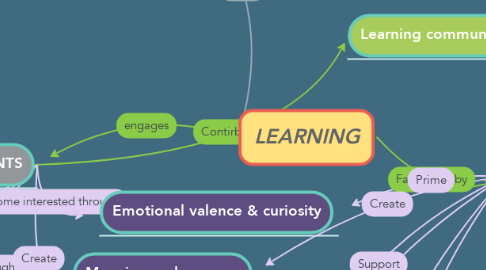LEARNING
by Catherine Roy

1. Learner characteristics
1.1. Digital natives
1.1.1. Prefer authentic learning experiences
1.1.2. Prefer doing
1.2. Digital immigrants
2. Emotional valence & curiosity
3. Forgetting processes
3.1. Interference
3.1.1. Retroactive
3.1.2. Proactive
4. Memory building processes
4.1. 1.Motivated interest
4.2. 2.Selectivity
4.3. 3. Intention to remember
4.4. 4. Basic background
4.5. 5. Meaningful organization
4.6. 6. Recitation
4.7. 7. Consolidation
4.8. 8. Distributed practice
5. Type
5.1. Domain-specific
5.2. General
5.3. Strategic
6. Acquisition
6.1. Encoding
6.2. Proceduralization
6.3. Composition
7. Learner processes
8. Knowledge
9. STUDENTS
10. Behaviourism
11. Cognitivism
12. constructivism
13. Learning approches
14. Structure
14.1. Holistic
14.2. Atomisitc
15. Meaning
15.1. Deep
15.2. Surface
16. Meaning and purpose
17. Goals
18. Active engagement & visual learning
19. Pausing, processing, categorizing & clustering
20. Practice, rehearsal and reflection
21. Personal meaning and mastery
22. Metacognition & self-regulatory strategies
23. Motivation
23.1. Value
23.2. Expectancy
24. Expectancy components
24.1. Self-efficacy beliefs
24.2. Control beliefs
25. Value components
25.1. Goal orientation beliefs
25.2. Task value beliefs
26. TEACHERS
27. Technology
28. Learning communities
28.1. Collaborative Learning
29. social constructivism
30. Articles color key
30.1. Glover 1990
30.2. Meyer 1992
30.3. Ertmer & Newby 2008
30.4. Ertmer & Newby update 2013
30.5. Ramsden Chapter 4 2003
30.6. Ramsden Chapter 7 2003
30.7. Pauk Forgetting 1974
30.8. Pauk Building memory 1974
30.9. Goodwin 2018
30.10. Powell 2009
30.11. Pintricht 2009
31. cognitive constructivism
32. Approaches to teaching
32.1. Theory 1
32.2. Theory 2
32.3. Theory 3


